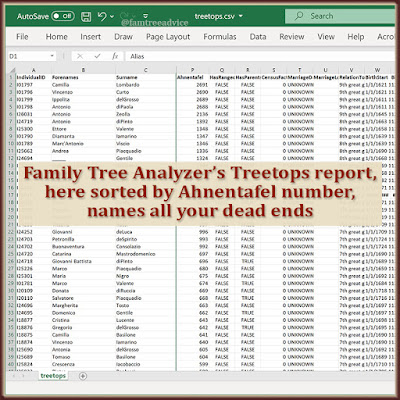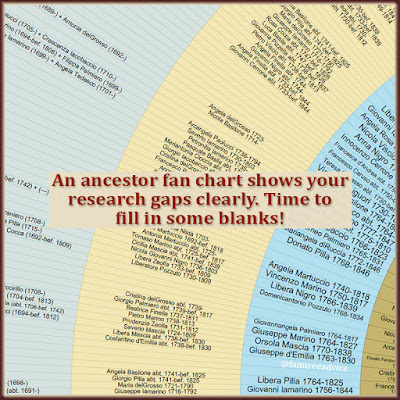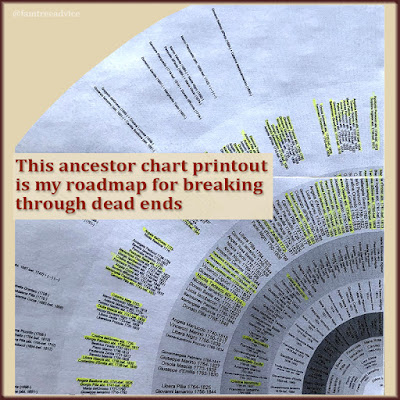Two weeks ago I wrote about searching the treetops to break through your dead ends. Let me tell you about the great success I had. Here's how I did it:
- I printed out a large fan chart of my ancestors.
- I used a highlighter to mark the names of my oldest known ancestors.
- Three-eighths of my family lines come from one Italian town, Colle Sannita. I began there because I've created the ultimate database of every available vital record from that town.
- One by one, I searched my database for the names of my highlighted ancestors.
- I found the death records of EIGHT of my 6th great grandparents! They were sitting there, waiting for me to find them. Now I know the names of their parents—my 7th great grandparents.
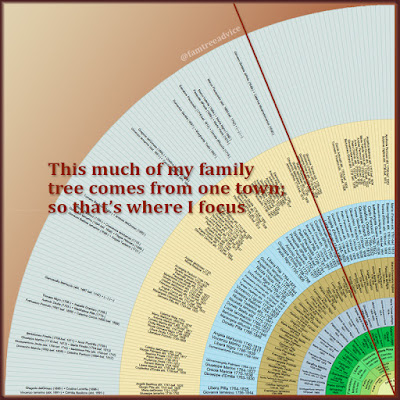 |
| Printing a fan chart of my ancestors made it clear where most of my roots come from. I'm researching that town full blast! |
In some cases, things got even better. Take my 6th great grandfather, Giorgio Iacobaccio. He was one of my dead ends, born in 1733. I knew his wife was Antonia Cioccia, and I had plenty of information about 3 of their children.
When I found a record of Giorgio's 1791 death, I had the names of his parents, born in the very early 1700s. That made them suitable for my favorite research aid.
I'm the proud owner of a book that details every living person in my ancestral town in the year 1742. That year the town performed a full census, listing:
- the head of household and his age
- whether he owned or rented his home
- everything he owned, from donkeys and sheep to vegetable gardens and vineyards
- the name, age, and relationship of everyone living in the household
It's a freaking gold mine of information. Exploring my treetops often leads me to search for a family in the 1742 census. I found my 6th great grandfather Giorgio Iacobaccio in the book because I knew his parents' names.
There I learned so much more.
Giorgio lived in the home of his uncle Carlo. Carlo was a 51-year-old shoemaker who lived in his own house, and owned 2 other houses. He had a donkey and 5 different plots of land.
Carlo didn't have a wife or children in his home. He had his mother, Camilla Grasso—my 8th great grandmother born in 1669. And he had his sister-in-law (my 7th great grandmother) Caterina and her children. This told me that my 7th great grandfather (Carlo's brother Nicola) was dead by 1742. His widow Caterina diPinto lived in Carlo's house with her 4 children.
My 6th great grandfather Giorgio, formerly my dead end, was the 2nd oldest child at age 9. The youngest child, Margherita, was only 4. So I know my 7th great grandfather Nicola must have died between 1738 and 1742.
When I searched for my next dead end, Giorgio's wife Antonia Cioccia, I had the same luck. I found her family in the 1742 census, and I found the name of my 8th great grandfather Carlo Cioccia, born about 1677.
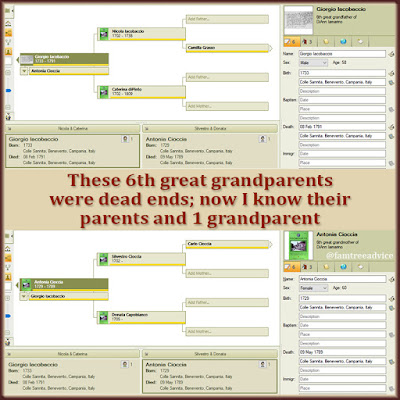 |
| Pairing up my own hometown database of vital records with an historian's book about the town is breaking through to new generations. |
Before I search the treetops of my other ancestral towns, I want to keep exploring the 1742 census. Each time I place a 1742 family into my family tree, I put a checkmark by their listing in the book. And I cross out their listing in the index. My goal is to place the entire book in my tree.
This is the ultimate jigsaw puzzle. I'm viewing each unchecked family in the book and searching for their names in my town database. Sometimes I get lucky and make a positive ID. Then the whole family goes into my tree.
This entire exercise is making my family tree grow so fast! I'm busy adding facts, documents, and sources. After a long day of adding details, I synchronize my Family Tree Maker file with my tree on Ancestry.com.
Why am I doing all this, going so far? I'm creating the ultimate resource for every descendant of this town. (I have shared my database, too.) We are all over the world, living in different cultures, but formed by the same roots.
This will be my legacy. What will yours be?



